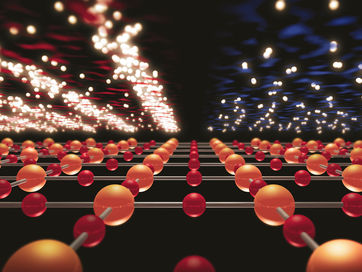'Exotic' material is like a switch when super thin
Advertisement
Researchers from Cornell University and Brookhaven National Laboratory have shown how to switch a particular transition metal oxide, a lanthanum nickelate (LaNiO3), from a metal to an insulator by making the material less than a nanometer thick.
Ever-shrinking electronic devices could get down to atomic dimensions with the help of transition metal oxides, a class of materials that seems to have it all: superconductivity, magnetoresistance and other exotic properties. These possibilities have scientists excited to understand everything about these materials, and to find new ways to control their properties at the most fundamental levels.
The team of researchers, which published its findings online in Nature Nanotechnology (to appear in the journal's May issue), includes lead researcher Kyle Shen, associate professor of physics; first author Phil King, a recent Kavli postdoctoral fellow at Cornell now on the faculty at the University of St. Andrews; Darrell Schlom, the Herbert Fisk Johnson Professor of Industrial Chemistry; and co-authors Haofei Wei, Yuefeng Nie, Masaki Uchida, Carolina Adamo, and Shabo Zhu, and Xi He and Ivan Božović.
Using an extremely precise growth technique called molecular-beam epitaxy (MBE), King synthesized atomically thin samples of the lanthanum nickelate and discovered that the material changes abruptly from a metal to an insulator when its thickness is reduced to below 1 nanometer. When that threshold is crossed, its conductivity – the ability for electrons to flow through the material – switches off like a light, a characteristic that could prove useful in nanoscale switches or transistors, Shen said.
Using a one-of-a-kind system at Cornell, which integrates MBE film growth with a technique called angle-resolved photoemission spectroscopy (ARPES), King and colleagues mapped out how the motions and interactions of the electrons in the material changed across this threshold, varying the thickness of their oxide films atom by atom. They discovered that when the films were less than 3 nickel atoms thick, the electrons formed an unusual nanoscale order, akin to a checkerboard.
The results demonstrate the ability to control the electronic properties of exotic transition metal oxides at the nanometer scale, as well as revealing the striking cooperative interactions that govern the behavior of the electrons in these ultrathin materials. Their discovery paves the way for making advanced new electronic devices from oxides.
Other news from the department science
Most read news
More news from our other portals
See the theme worlds for related content
Topic World Spectroscopy
Investigation with spectroscopy gives us unique insights into the composition and structure of materials. From UV-Vis spectroscopy to infrared and Raman spectroscopy to fluorescence and atomic absorption spectroscopy, spectroscopy offers us a wide range of analytical techniques to precisely characterize substances. Immerse yourself in the fascinating world of spectroscopy!

Topic World Spectroscopy
Investigation with spectroscopy gives us unique insights into the composition and structure of materials. From UV-Vis spectroscopy to infrared and Raman spectroscopy to fluorescence and atomic absorption spectroscopy, spectroscopy offers us a wide range of analytical techniques to precisely characterize substances. Immerse yourself in the fascinating world of spectroscopy!































































